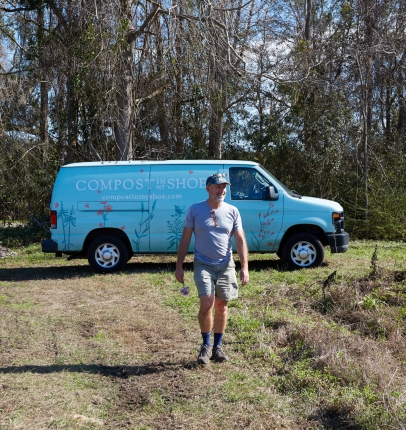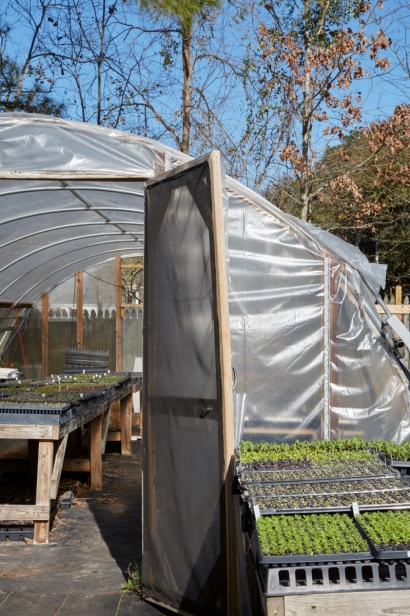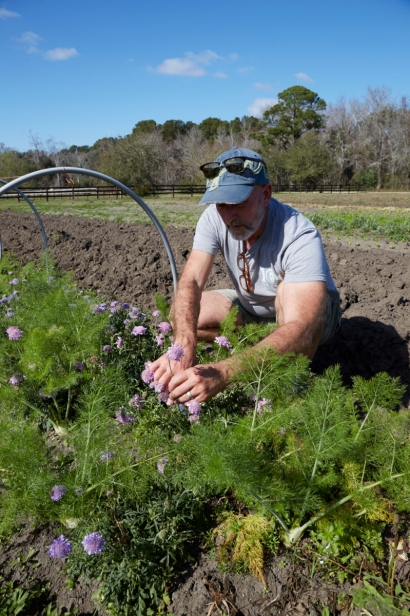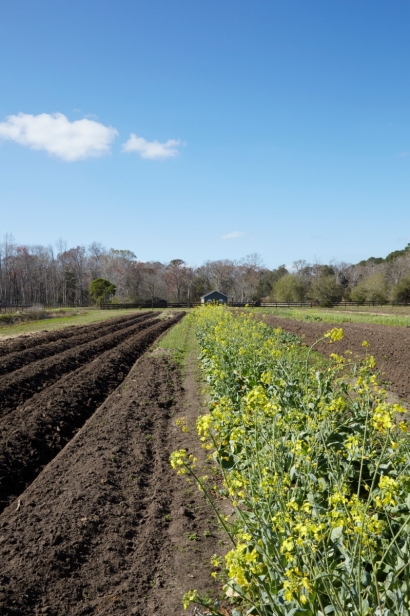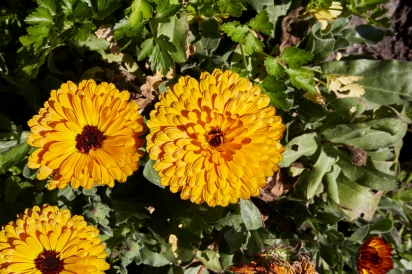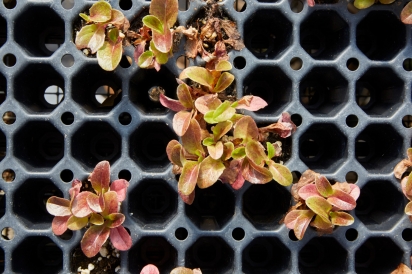Petal Pusher: The Blooms, Shoots and Leaves of Jim Martin
“Let’s face it, flowers are flashy,” says the Lowcountry’s horticultural wunderkind, Jim Martin, always one to cut to the chase. And to cut flowers, especially now that the vegetable and herb grower and purveyor of Compost in My Shoe is moving more and more toward florals. They were his first love, after all; at 8 years old, he loved weeding his family’s garden of lilacs, zinnias and marigolds, and being wowed by the dazzling kaleidoscope of blossoms.
“I was the only kid that anyone knew of who enjoyed weeding,” he says. “To this day, I still do. It’s so therapeutic. You float away—it’s like meditation to me. I just love it.”
It has taken three decades in agriculture and gardening for this Jim-of-all-trades (farmer, photographer, writer, garden designer, beekeeper, non-profit leader, teacher) to return to his early plant passion.
Martin grew up on an Ohio dairy farm and moved to South Carolina as a young teen. He earned a horticulture degree from Clemson, “during what I call the chemical years—I got out of school and said ‘screw that’—I know another way,” he says, and has since gone about doing just that, as a founding board member of the Charleston Horticultural Society, and through head botanical posts at the Riverbanks Zoo and Brookgreen Gardens, and, for the past 10 years, with the Charleston Parks Conservancy.
In 2010, he launched Compost in My Shoe as his own farming and beekeeping side gig—the “shoe” referencing a guy always on the go between office and garden, board room and compost heap, with toes in many pots, so to speak.
Today that roving compost gets mixed into beds of ornamentals in addition to the Swiss chard, beets, carrots and potatoes, among the many vegetables and herbs that Martin grows.
“For me, flowers have always been the end game, and I’m moving toward that transition,” he says. “I still have a long way to go to master the vegetables and herbs, but the floral is like the new world—really exciting.”
Slow Flowers
Martin approaches his fields of flowers as he does all the produce he grows on acreage he leases on—get this—Full Circle Farm. He farms using organic methods only, and “I grow locally, which means bringing in as many local resources as we can. It’s about the ‘times three, times six, times 12’ factor of local touch points based on my practices,” he explains. “I also sell my product locally, and educate consumers locally. Every aspect of it points to local.”
In this way, Martin views growing “Slow Flowers” in the same vein as food that is grown, prepared and consumed in the Slow Food movement. The carbon footprint of a dahlia harvested on Johns Island and showcased in a locally designed Charleston wedding bouquet is minimal compared to one using cut flowers shipped from abroad. NAFTA, he notes, killed the U.S. cut flower industry, as local growers were unable to compete with inexpensive imports from Colombia, Ecuador and Europe.
“But that’s beginning to change, and people are more interested in and educated about how and where things they consume are sourced,” says Martin. “Whether it’s agricultural products we grow and eat or those that we consume visually, it’s all about tying in to our community.”
Growing ornamentals, though a welcome and promising challenge, is not all rosy.
“It’s more complicated than you might expect, and the nuances are totally different from growing other produce,” he says.
The time invested from seed to harvest can be three to four months longer than a vegetable crop, for instance. Specialized crops, such as digitalis and delphiniums, are even harder and take longer. Martin has helped organize Lowcountry Flower Growers, as a resource for the core group of three or four other locals facing the same education and marketing challenges.
“I’m definitely still learning, still trying to figure out the ideal mix,” he says.
Digging Design
What keeps Martin petal-pumped, however, goes beyond growing and selling beautiful flowers.
“First and foremost, I’m a designer, and I get to play with all this stuff!” says Martin, who remembers as a kid being wowed by dramatic gladiolas (“You plant a big bulb then get this stalk with all these flowers—how can you go wrong with that?”). He loves the creative freedom in floral design, especially the opportunity to shine a light on varietals that may have gotten a bad rap, like chrysanthemums and calla lilies, which many consider “funeral flowers,” he says. “They’re incredibly beautiful, but they have this stigma. I get to help people see them differently; I can make them look any way I want, and that excites the hell out of me.”
To that end, Martin has been studying the floral arts with some of the world’s most renowned designers. He’s attended workshops in Vancouver, Paris and Barcelona with Hitomi Gilliam, and for the past five years has studied with the esteemed Tomas De Bruyne.
“I am so, so fortunate to work with these artists,” says Martin, who will soon earn his European Masters Certification, an intensive process he began in 2011. “I just fell in love with the people and the whole art form. It gives me a chance to be as creative as I want to be.”
Does he have a favorite flower? “Yes. A new favorite every other day,” says Martin, who considers structure work his design flare, in addition to his “flamboyant” use of color—“I am not demure,” he says with a wink. And in between picking favorites, he’s picking and growing everything else, keeping his many CSA farm share customers well fed and happy. Come blackberry season, they’ll enjoy getting some nice, juicy berries in their weekly bundle, and probably never realize that Martin is growing them largely because “berries are big in design work.”
For now, his floral arts are more hobby than business, but the beauty—besides their natural beauty—is that it all feeds the same farming and Slow Food instinct.
“When we talk about ‘edible,’ we’re really talking about all our senses, how we eat things up,” Martin says. Lucky for us, his appetite for flowers is big, and growing.


